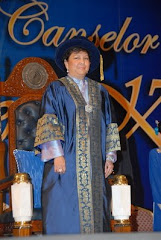
Open university Malaysia, in collaboration with Esterhazy Karoly College, Eger, Cadi Ayyad University Marrakech, Morocco and Delta Academy of Science, Egypt, will be organizing "The International Conference on Information (ICI9)" from 12-13 August 2009 at the Legend Hotel, Kuala Lumpur
Details are as follows:
Main Theme
Learning Innovations in Higher Education
Innovation has, and will always be, a key factor for the progress of humankind. Being innovative is vital for getting ahead, including in higher education. Open and Distance Learning (ODL) is one such innovation that was borne to meet new global demands and break many barriers in higher education. With ODL and the technologies that come with it, learning can happen for anyone, anywhere, anytime.
This conference aims to bring together innovations and ideas in higher education unto one common platform. Innovators and practitioners will have a chance to share findings and experiences as well as explore the many technologies that have shaped, and will continue to influence, higher education and ODL.
Sub-themes
E-LEARNING
With the advent of the World Wide Web, e-learning has truly taken off as a viable way of studying at a distance via electronic applications and processes. With the Internet at its very core, e-learning includes computer-based virtual learning environments that allow learning to happen through both synchronous and asynchronous modes. We welcome papers that discuss and illustrate the challenges and innovations that make e-learning such an integral part of today’s higher education.
OPEN LEARNING
Higher education is no longer just a concern for school-leavers. Many working people today continue to seek higher education as a means for self-improvement and career development. Open learning, a subset of distance education, offers the flexibility required by such individuals through various choices in admission, curricula, time, space and resources. We welcome researchers and practitioners of open learning to share their experiences by submitting papers under this sub-theme.
MOBILE LEARNING
Mobile devices such as cell phones and MP3 players are some of the most ubiquitous technologies available in the world today. Mobile learning (mLearning) thus leverages on mobile devices to motivate and engage learners, especially those studying through ODL. Information can be relayed and stored in mobile devices, making learning a portable and flexible experience. We invite presenters to share approaches and innovations, ideas and developments, which outline this exciting new form of learning.
EMERGING TECHNOLOGIES
Since the birth of personal computers, the technology boom has moved at lightning speed with new devices and tools being introduced all the time. These technologies can considerably impact teaching and learning by providing new ways to teach, learn, research and share. We welcome all papers that address these new technologies, their implementation as well as issues, in a higher education setting.
LEARNING ASSESSMENT
Assessment is a focal part of education. In higher education, both formative and summative assessments contribute to measuring how much one has learned in an academic programme. We are interested in papers that reflect the types, methods, challenges, technologies and tools that can be applied for a practical and effective assessment system in higher education, and especially ODL.
Important Dates:
Deadline for Abstracts: 15 May 2009
Notification of Acceptance Abstracts: 1 June 2009
Deadline for Full Paper Submission: 15 July 2009
Conference Registration: 30 July 2009
Conference: 12 & 13 August
For further details, kindly visit: http://ici9.oum.edu.my/index.php




